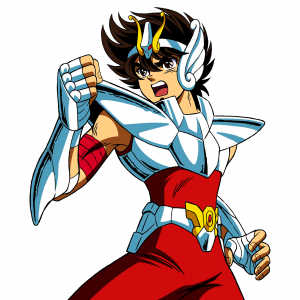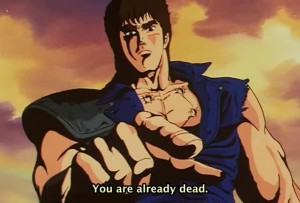How Saint Seiya Became Popular
 Let me take you back to early 80s Japan. The country’s economy is in a boom – the highest point since the war, with an average of 4% growth per year throughout the decade. Unemployment is at less than 5%. Japanese people suddenly found themselves with a lot of disposable income, which led to a natural increase in entertainment products, such as movies and comic books. Additionally, videogames such as Donkey Kong and Super Mario Bros. gain Japan worldwide recognition, forever sealing its place as the premier developer of videogames – a position that it would hold for at least the next 20 years, and arguably for a lot more. But there was another character created around the same time who, while not nearly as popular as Mario, proved to be just as influential. His name… is Kenshiro.
Let me take you back to early 80s Japan. The country’s economy is in a boom – the highest point since the war, with an average of 4% growth per year throughout the decade. Unemployment is at less than 5%. Japanese people suddenly found themselves with a lot of disposable income, which led to a natural increase in entertainment products, such as movies and comic books. Additionally, videogames such as Donkey Kong and Super Mario Bros. gain Japan worldwide recognition, forever sealing its place as the premier developer of videogames – a position that it would hold for at least the next 20 years, and arguably for a lot more. But there was another character created around the same time who, while not nearly as popular as Mario, proved to be just as influential. His name… is Kenshiro.
Hokuto no Ken, also known as Fist of the North Star, began publication in the weekly manga magazine “Weekly Shonen Jump” on September 13th, 1983, and very quickly became a phenomenon. The manga featured an overly masculine protagonist named Kenshiro who was extremely fluent in martial arts walking around a post-apocalyptic world and solving everybody’s problems while occasionally shedding a few manly tears (I’m not kidding here – if you google “manly tears”, most of the images depict Kenshiro). Hokuto proved to be unbelievably successful, beyond anyone’s wildest dreams. While there have been martial arts manga series before, none proved to resonate with audiences as well as Hokuto, which continued for 5 years and spawned multiple anime series, several movies (including a hilariously bad American version starring Gary Daniels and his mullet) and too many videogames to count. It became a phenomenon that influences the manga/anime culture to this very day, with fans still repeating the famous phrase “You are already dead” (often spoken when Kenshiro has killed his opponent without them realizing it yet) to this very day.
 Hokuto‘s popularity gave rise to martial arts mangas that followed the same formula. Numerous attempts were made, some successful (such as 1984’s DragonBall) and some not. One of those attempts was Saint Seiya, created by Masami Kurumada. While not a direct ripoff of Hokuto, the influences were obvious – Saint Seiya also had a highly masculine protagonist (though more emotionally than physically) who used martial arts to right wrongs. But there were also several differences – for example, instead of a desolate wasteland, the Saints (Saint Seiya‘s word for martial artist) fought in a world that mixed sci-fi and Greek mythology settings, and instead of a sole protagonist wandering with a small supporting cast that mostly cheer him on, main character Seiya was joined by four other Saints. But there was another extremely important difference, one that I believe helped elevate Saint Seiya above the status as “just another martial arts” manga. While Hokuto no Ken was aimed at adults, with hyper-violence, complex themes and often depressing or bittersweet endings, and DragonBall was unquestionably aimed at little boys, with a child protagonist, simple plots and unquestionably evil bad guys, Saint Seiya managed to hit the tonal middle ground in order to appeal to almost everyone.
Hokuto‘s popularity gave rise to martial arts mangas that followed the same formula. Numerous attempts were made, some successful (such as 1984’s DragonBall) and some not. One of those attempts was Saint Seiya, created by Masami Kurumada. While not a direct ripoff of Hokuto, the influences were obvious – Saint Seiya also had a highly masculine protagonist (though more emotionally than physically) who used martial arts to right wrongs. But there were also several differences – for example, instead of a desolate wasteland, the Saints (Saint Seiya‘s word for martial artist) fought in a world that mixed sci-fi and Greek mythology settings, and instead of a sole protagonist wandering with a small supporting cast that mostly cheer him on, main character Seiya was joined by four other Saints. But there was another extremely important difference, one that I believe helped elevate Saint Seiya above the status as “just another martial arts” manga. While Hokuto no Ken was aimed at adults, with hyper-violence, complex themes and often depressing or bittersweet endings, and DragonBall was unquestionably aimed at little boys, with a child protagonist, simple plots and unquestionably evil bad guys, Saint Seiya managed to hit the tonal middle ground in order to appeal to almost everyone.
First and foremost, all violence was significantly toned down when compared to Hokuto no Ken. While there are certain instances of violence, such as an infamous event in which Seiya sticks his hand into the chest of one of his enemies in order to kill him, for the most part the violence is very PG-friendly, yet without compromising the integrity of the martial arts, which still remained impressive even just on paper. Additionally, while the villains never exactly argued philosophy with Seiya, they still had realistic goals and weren’t just moustache-curling, dastardly bad guys like in so many other mangas around that time (even quite a lot of the much more mature Hokuto villains fell into this trap). And at the end of the day, the messages of Saint Seiya just resonated with the readers. While Hokuto was about a lone man trying to bring at least some hope to a world that has none, Seiya is all about companionship. It’s about learning to rely on your friends and working together with them in order to protect something that’s precious to you. They’re themes that hadn’t really been explored in a popular martial arts manga up until then (most of which tried to copy Hokuto‘s sole protagonist), yet have become staples of the genre since then, becoming prevalent in some of the most popular mangas in the following years such as One Piece, which holds the theme of companionship and fighting for what you believe in at its very heart and is, to this day, the best-selling manga ever. Seiya didn’t just come out at exactly the right time to grab people’s interest – it also knew how to keep it.
In 2015, Saint Seiya‘s legacy is arguably just as big as that of the manga which inspired it. It spawned an anime that ran for 114 episodes (half of which were dubbed into English, albeit poorly, and aired as Knights of the Zodiac), alongside another series of OVAs, multiple spinoffs (some of which are still airing today) and way too many videogames to count. It has been almost 25 years since the original manga ended, and yet new stories bearing the Saint Seiya name continue to appear constantly, as recently as September 25th 2015 when Saint Seiya: Soldier’s Soul hit store shelves worldwide. Even if it started as nothing more than a ripoff trying to cash in on the immense popularity of the martial arts manga genre in the mid-1980s, Seiya has since grown into one of the most beloved and fondly remembered martial arts series ever made.
